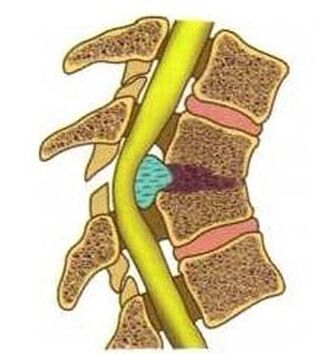Osteochondrosis is a degenerative-dystrophic spinal disease in which the lesion of the intervertebral discs in the form of their deformation, reduction of height and stratification is noted. The manifestations of this pathology are varied, but they can be combined in several syndromes. Depending on the severity of the symptoms, changes in the intervertebral discs around their structures differ several stages of osteochondrosis. Before treating osteochondrosis of the cervical region, it is important to understand why different medicines, physiotherapy and surgical methods are needed.
Osteochondrosis of the cervical spine most often develops in people over 35 years of age, but sometimes its manifestations are observed at the age of 18-30 years. The spine consists of vertebrae, the most mobile of them is usually affected-5th, 6th, 7th.
Between the vertebrae are the intervertebral discs, which are a special form of the most durable cartilage bone. They ensure the ability of the spine to withstand considerable loads and its mobility.
Each intervertebral discs consists of:
The intervertebral discs are connected to the vertebrae bodies using a ligament apparatus.
In people over 20 years of age, the vessels that feed intervertebral discs are overgrown. In the future, these structures receive all the necessary substances through diffusion from a number of arranged vertebrae, but often these processes are insufficient for normal metabolism in the disks.
Osteochondrosis of the cervical spine most often develops under the influence of:
These factors exacerbate impaired eating of the intervertebral discs. As a result, the pulp nucleus is flattened, they become less elastic. The load on the fibrous rings increases, which is accompanied by their stretching, the formation of cracks in them.
Against the background of such degenerative changes, the intervertebral disc can protrude to the spinal canal. Irritation of the posterior longitudinal ligament, rich in nerve endings, is accompanied by local pain.
With the progression of the disease, a rupture of the posterior longitudinal ligament occurs, the intervertebral disc is protruding into the cerebrospinal canal, this condition is called hernia. At the same time, Rooster syndrome develops, caused by irritation of the closest cerebrospinal spine, local autoimmune inflammation. If the radicular artery is squeezed, the blood supply to the spinal cord is impaired.
Osteochondrosis of the cervical spine is accompanied by the formation of osteophytes - bone tissue growths on the bodies, the processes of the vertebrae. These entities can also pull out the roots of the spinal nerves or spinal cord.
The osteochondrosis of the cervical-thorned department at the initial stage is accompanied by tension, rapid fatigue of the muscles of this area. Subsequently, discomfort, pain in the nape, neck, shoulders, intensifying during inclinations, joined the turns of the head.
Dizziness, headache - another first signs of cervical osteochondrosis in women, men. Sometimes a person experiences pain, a feeling of tingling, numbness in his hands after a night's sleep.
The osteochondrosis of the cervical spine is most often characterized by:
Some people have reflexive dystrophic syndromes, discogenic cervical myelopathy. Often there are also disorders in the emotional sphere, panic attacks with cervical osteochondrosis.
The manifestations of radicular syndrome are caused by compression (compression) of the root of the spinal nerves of the hernia of the intervertebral discs, the osteophytes of the bodies, the processes of the vertebrae themselves. As a result of nerve fiber compression, a local inflammatory reaction develops, which is accompanied by pain through the cold of the affected nerve.
Therefore, in cervical osteochondrosis, symptoms such as neck pain, arms, areas of the back occur. In the heart, the stomach can be noted unpleasant sensations. If neck pain remains constant, increases when rotating, tilting the head, this condition is called cervikagia. Also, the pain can have the character of Lumbago, to be given in the hand, they are called servicio.
In those areas that innervate the affected nerve, there is a pronounced decrease in sensitivity. The muscles in this area become greater, their atrophy can be noted, which is accompanied by a decrease in their volume.
The peak artery is a paired blood vessel that provides blood supply to the brain by 15-30%. When the spinal artery is pressed, various chronic manifestations of oxygen failure in the central nervous system are indicated by the altered intervertebral discs, the growth of the vertebrae.
In the development of this condition, 2 stages are distinguished: functional, organic (ischemic). In the first of these, the main symptoms of spinal artery syndrome with cervical osteochondrosis are frequent headaches. They become more pronounced in the movements of the head, as well as while maintaining one position for a long time. The pain hurts or throbs, felt in the back, temporary, frontal areas.
Dizziness of cervical osteochondrosis is also characteristic of the functional stage of this syndrome. Its intensity is different: from a feeling of instability to a feeling of sudden falling or rapid rotation of the body. Sometimes hearing is reduced, a person can be disturbed by the noise in the ears. Visual disorders are noted in the form of flies, glimmering in front of the eyes.
With the progression of the pathology, an ischemic stage appears. It is characterized by temporary disorders of cerebral circulation in the form of transient ischemic attacks, the appearance of which are often provoked by a rapid inclination or rotation of the head.
There are several options for spinal artery syndrome, with cervical osteochondrosis, the manifestations of which have their own characteristics:
With an attack on a drop of one suddenly falls, he throws his head back, he cannot move. Conscious losses are not noted, the ability to move independently in a few minutes. This condition is caused by insufficient blood flow to the cerebellum, the brain stem.
Cervical migraine syndrome occurs due to compression of alternated interpretations or osteophytes of nerve plexus surrounding the spinal arteries. This condition is characterized by stupid headaches that periodically become throbbing. They usually occur if you need to maintain a forced position of the head for a long time, for example, this often happens after sleeping on an uncomfortable pillow when you work on your computer. A similar headache for osteochondrosis of the cervical region become stronger during descent, climbing the stairs, trembling while driving in transport, fast walking. The pain is located on the one hand in the back area, applied to the front of the head. They can last from a few minutes to hours.
Syncopa vertebral syndrome occurs due to insufficient oxygen intake to the reticular brain formation. This condition is accompanied by a short -term seizure, with a long stay of the head, the neck in a forced position.
Symptoms of cervical osteochondrosis in women, men in the form of pain, the feeling of sand in the eyes, sparks in front of them are some of the manifestations of ophthalmic syndrome. There is a decrease in visual acuity, which is more pronounced with increased eye load, partial loss of vision fields is possible. Closure occurs, the redness of the conjunctiva is noticeable.
The attack of the main migraine begins with a decrease in vision of both eyes, tinnitus, impaired gait, lubrication of speech. Dizziness with cervical osteochondrosis of this version of the course is also noted. Then there is a severe headache in the back area, accompanied by vomiting, the attack ends with a loss of consciousness.
With the development of Cochleo Investments Syndrome, when it involves the pathological process of the spinal artery in the ears, one notes a decrease in hearing and the perception of whispering speech is particularly difficult. The feeling of the instability of your body in space, a sense of rotation of nearby objects.
Vegetative dysfunction syndrome reflects disorders of the autonomic nervous system in response to the spinal artery, the nerve fibers located around it. It is characterized by a feeling of heat, attacks of chills, increased sweating. The legs, the palms turn cold, wet by touching and sew pain in the heart. The autonomic symptoms of cervical osteochondrosis in men usually accompany the manifestations of other syndromes.
Transher ischemic attacks suddenly occur attacks of impaired movement coordination, severe dizziness, speech damage, nausea and vomiting. If a person occupies a horizontal position, these manifestations are usually reduced. After such an attack, headache, weakness, flies, glimmering in front of the eyes, the noise in the ears is maintained for a while.
Sometimes there is an increase in blood pressure with cervical osteochondrosis, which is also a consequence of the squeezing of the vertebrae. As a result, the brain area, which is responsible for regulating pressure, lacks oxygen. The same nerve impulses occur in it as with reduced blood pressure, under the influence of which it increases sharply.
With the development of degenerative-dystrophic changes in the intervertebral discs, osteochondrosis in its development passes several stages.
At this stage, the osteochondrosis of the cervical-tonight department is accompanied by muscle tension, discomfort. There is a slight smoothness of the cervical lordosis (physiological bending of the spine in the form of its bulge forward). Sometimes pain occurs in this area is possible to temporarily reduce the sensitivity in the collar area.
There is a feeling of weakness in the hands, numbness of the skin of the face, neck, also reduces sensitivity in the upper limbs. The vision worsens, there is noise in the ears.
At this stage there is a rupture of the intervertebral disc with or without its formation. Neck pain, the area of the collar becomes more pronounced, constant, is given in their hands.
With osteochondrosis of the cervical spine, not only the intervertebral discs, vertebrae, but also nerve fibers, blood vessels participate in the pathological process, sometimes the spinal cord, muscles, joints of the upper half of the body are affected. The symptoms of the disease are varied, similar to signs of other pathological conditions. If osteochondrosis occurs, you should consult a doctor immediately to be examined.
Treatment of osteochondrosis of the cervical spine in the case of severe pain should first be directed towards stopping them. For this, painkillers are used. They are taken inside to achieve a faster effect with cervical osteochondrosis, solutions injections of these drugs are recommended.
Occasionally, a pepper patch is used, this tool irritates skin receptors, improves blood circulation in the area of use. As a result of such a distracting effect, experienced pain seems more pronounced.
Treatment of cervical osteochondrosis in women men with physiotherapy are aimed at:
The massage begins with the repayment of the collar area in the direction from the spine to the supraclavicular, axillary to areas. Then the sticks are performed, as the massage therapist puts his hand with an edge perpendicular to the spine, moves it from top to bottom. In the future, friction is used in order to heat the muscles, to improve the local blood flow. The fingers are made by straight, circular motions, starting from the base of the skull. Then, in a circular motion, the muscles mix in the area of the collar area. To complete the massage, vibration movements are used in the form of turmoil as well as repayment.



















